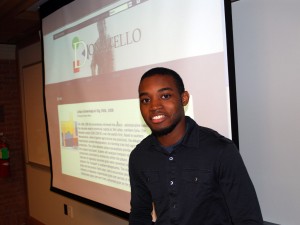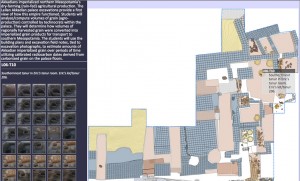 This week Associate Director David Hirsch and Senior Programmer Peter Liu from CMI2 and Instructional Technologist Matt Regan and Instructional Support Manager Gloria Hardman from ITG spoke about the pilot program they are currently running on the Classes*v2 called, “Media Gallery.” Through Media Gallery, professors, students and teaching fellows are able to upload, organize and present video and audio content on their Classes*v2 course sites. Currently there are about fifteen courses involved in the pilot program, which has begun to reveal some of the benefits (and bugs) of the system. Tracking the pros and cons of the system will allow CMI2 and ITG to better adapt the program to fit Yale’s teaching and learning needs.
This week Associate Director David Hirsch and Senior Programmer Peter Liu from CMI2 and Instructional Technologist Matt Regan and Instructional Support Manager Gloria Hardman from ITG spoke about the pilot program they are currently running on the Classes*v2 called, “Media Gallery.” Through Media Gallery, professors, students and teaching fellows are able to upload, organize and present video and audio content on their Classes*v2 course sites. Currently there are about fifteen courses involved in the pilot program, which has begun to reveal some of the benefits (and bugs) of the system. Tracking the pros and cons of the system will allow CMI2 and ITG to better adapt the program to fit Yale’s teaching and learning needs.
Kaltura, the media hosting platform that is being used as the platform for Media Gallery, is an exceptional fit for Yale’s needs for two reasons in particular: the program is open source (providing flexibility for Yale-tailored modifications) and all media is hosted on a dedicated media server (ie not a Yale server).
Basic functions of Media Gallery are easy enough for even the novice user. To upload material off of one’s personal computer, only a few simple steps need to be followed. The first step is to access the course site by logging in classesv2.yale.edu. Instructors or teaching fellows can then select a file, which will be uploaded to the Kaltura server. Once on the Kaltura server, the media files will be transcoded into standard formatting before being stored as links inside the course site library. Any metadata chosen to be associated with the content—title, description, tags—will appear in the course site library with the link to the media file. Tags in particular are especially beneficial as course instructors begin to organize the media files inside the library by creating “collections.”
To explain the capacities and detractors identified during the pilot, Matt oscillated between his real account (the Yale Matt) and account (his alter ego with special powers). Gloria, in turn, channeled Julia Child, whose included “files already sitting on the drive, ready for upload.”
Here are the pros and cons of the program.
PROS
Most video and audio formats are supported, with the notable exception of MP4 audio files. Media files can be easily incorporated into existing functions of Classes*v2, such as tests, quizzes, and even resources. Permission to use the files is done through Classes*v2, allowing for simple access control. While instructors can download files and/or copy the files’ embed codes, students cannot. Like with material currently being uploaded under “Resources,” responsibility lies with the individual professor to abide by copyright terms and restrictions of fair use.
There is a great deal of growth potential within the existing program. Not only does the open source nature of the program enable tailored modifications, but there are programs possible through Kaltura that are not currently implemented but might be incorporated in the future. For insantce, remixing and clip creation through a web-based media editor is possible through Kaltura. This function would allow film studies professors, wanting to teach students about clip order, to upload a number of clips, encouraging students to play with order to consider its effects. Similarly, image uploading is current disabled, though possible.
CONS
The biggest benefit of the pilot program is that the testing process enables many of the program’s bugs to be rendered obsolete for future users. For instance, there is a 2G upload limit, which makes Kaltura more suitable for shorter video clips than full-length films. Communication with Kaltura, however, indicates that the upload limit is likely to change soon. Also, the default option for media files is currently “hidden.” That means, occasionally, uploaded media content will be hidden from student’s page views without the instructor realizing (as the content is not hidden from the instructor’s page). Lastly, there is no “drag and drop” feature for the ordering of files within collections. Instructors who are concerned with order should be conscious of the order in which files are moved into collections files.
THINGS FOR USERS TO KEEP IN MIND
- Users, not courses, control media files. Media content is stored in association with the user who uploads it and then shared, by that user, with a course. Once the course has been completed, the media files stay with the individual who uploaded them to be reused for future classes. This does mean, however, that Media files included in a course by a TF will need to be re-uploaded by professors the second time the course is taught. Similarly, language courses using the same video content for multiple courses controlled by multiple professors cannot share the video content, but must instead upload videos separately.
- The more files uploaded, the more important metadata becomes. “My Content,” the automatic repository for media files, only shows ten clips at a time. While there is a search function, it’s relatively useless without meaningful tags associated with the content. Unfortunately, international characters are not currently supported in the metadata fields.
- Transcoding off of the Kaltura server can take a little while. Instructors can’t expect to upload a file to have it available for class five minutes later, unless the file is very small. That being said, most files are likely to take less than an hour to transcode, so any files uploaded the night before will certainly be readily available for class the next day. The transcoding, Gloria reminded us, “all takes place in Kaltura-land” so if instructors find themselves frustrated by these delays, they’re welcome to take it up with Kaltura. Alternatively, this also means that once the instructor has sent the file he or she is welcome to “go take a nap.”
After Matt and Gloria concluded their demo of the pilot, Martin Kane, Special Assistant for Spanish for Health Care Professionals at the CLS, closed the talk with a demo. His course, “Español for Healthcare Professionals,” is using the webcam capacities to record videos of students doing portions of a patient history in Spanish.
Want more? View their powerpoint presentation.
For full coverage of this session, please click the video below (note a slight delay upon initial playback):



